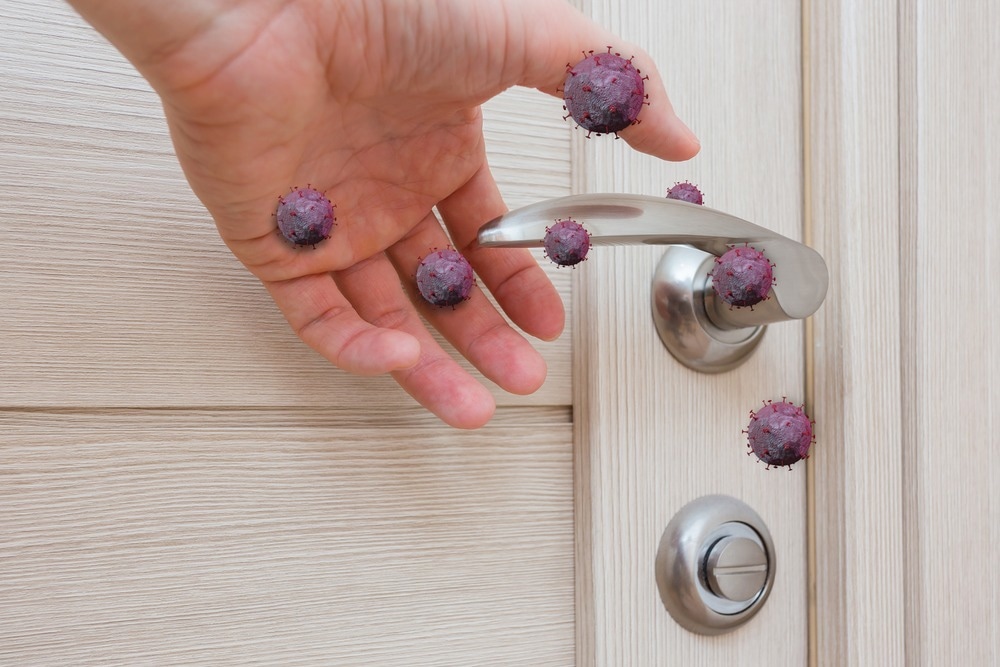The zoonotic monkeypox virus (MPXV), which is endemic to Africa, is typically transmitted through direct contact with an infected person or animal or through the inhalation of infected respiratory secretions.
Infection with MPXV often leads to the development of lesions with exudates that contain viable virions that can be shed during infection. As compared to other enveloped viruses, MPXV virions are more tightly bound with the fibrin matrices of the scab/crust, thereby allowing for them to persist within the environment for longer periods.

Study: Environmental Persistence of Monkeypox Virus on Surfaces in Household of Person with Travel-Associated Infection, Dallas, Texas, USA, 2021. Image Credit: Kapustin Igor / Shutterstock.com
A recent study conducted by the United States Centers for Disease Control and Prevention (CDC) and published in the journal Emerging Infectious Diseases assessed the viability and viral load of MPXV on household objects and surfaces.
About the study
Samples were collected from frequently used objects in the household of an individual who had been infected with MPXV. This sampling was conducted 15 days after the infected individual had left their home to be admitted to the hospital.
These samples were then incubated to allow for virus isolation and the detection of viable viruses. Importantly, any potential contamination with bacteria or fungi was prevented by treating all incubated samples with penicillin/streptomycin, amphotericin B, and gentamicin.
Following daily observation of the samples for cytopathic effect (CPE), all positive samples were processed and screened through the reverse transcription-polymerase chain reaction (RT-PCR) assay to confirm the presence of MPXV deoxyribonucleic acid (DNA).
 Colorized transmission electron micrograph of monkeypox virus particles (blue) cultivated and purified from cell culture. Image captured at the NIAID Integrated Research Facility (IRF) in Fort Detrick, Maryland. Image Credit: NIAID
Colorized transmission electron micrograph of monkeypox virus particles (blue) cultivated and purified from cell culture. Image captured at the NIAID Integrated Research Facility (IRF) in Fort Detrick, Maryland. Image Credit: NIAID
Study findings
A total of 31 samples were collected from the household, 10 of which were from porous surfaces such as cloth and paper, whereas the remaining 21 samples were isolated from nonporous surfaces such as sealed wood and plastic.
RT-PCR analysis revealed that 27 samples were positive for MPXV DNA, with a mean cycle threshold value (Ct) of 25.83. There was no significant difference between the detectable virus on porous and non-porous surfaces; however, the level of detectable viral DNA was higher in porous materials. Notably, the bedroom had the highest number of positive samples, followed by the bathroom, living room, and kitchen in descending order of PCR-positive samples.
Aside from RT-PCR-positive samples, seven samples contained viable viruses, three of which were obtained from the bedroom, three from the living room, and one from the closet. Notably, porous materials had significantly higher viable viral load than non-porous surfaces at 60% and 5%, respectively.
The environmental conditions of the household, combined with exposure to disinfectants and physical/chemical properties of the surfaces, could contribute to viral decay before sampling. Nevertheless, viral decay was less rapid on porous surfaces.
The persistence of MPXV also depends on the type of the initially deposited infectious material and viral load. The presence of sufficient viable viruses in fomites can cause secondary infections through mucous membranes or opportunistic contacts, depending on the immunity of the host. The estimated maximum duration of viable MPXV persistence under slightly reduced heat and humid conditions is between 28-70 days.
Conclusions
People infected with MPXV should be quickly isolated, with special precautions taken while handling materials and surfaces used by the patient. Appropriate respiratory protection and the use of commercial disinfectants for household cleaning are also warranted.
The risk potential of different objects within a household for MPXV contamination should be documented. Thus, adequate cleaning and disinfection protocols, along with specific recommendations to vulnerable persons and communities, should be publicized.
The infectivity of MPXV depends on the viral titers. Future studies, including those with multiple time point sampling protocols with a record of the environmental conditions, multiple applicator types, and different types of transport media, are recommended.
Considering the current MPXV outbreak in non-endemic areas, as well as the persistent threat of MPXV infections in endemic regions, further studies on the transmission dynamics of this virus are warranted.
Journal reference:
- Morgan, C. N., Whitehill, F., Doty. J. B., et al. (2022). Environmental Persistence of Monkeypox Virus on Surfaces in Household of Person with Travel-Associated Infection, Dallas, Texas, USA, 2021. Emerging Infectious Diseases. doi:10.3201/eid2810.221047.